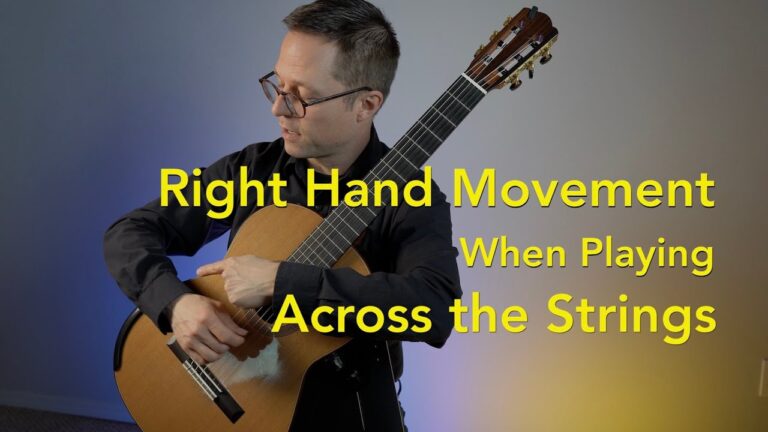Right Hand Fingering Lesson for Classical Guitar – How to choose right hand fingering is a common question for classical guitar students. Below is an overview lesson and a 4-part lesson series covering concepts and ideas related to choosing right hand fingering. The biggest takeaway: practice technique patterns that you can apply to your repertoire.
Refresher Lesson and Overview – The basic idea is that 90% of fingering should conform to regular patterns in your technique practice and the other 10% might need specific practice. That means, most of the time we just play through scale and arpeggio work regardless of awkward string crossings and other common patterns. The technique practice we’ve solidified allows us to simply play through most textures via our muscle memory without thinking too much about it. The remaining fingering gets worked out to avoid awkward string crossings and utilize ergonomic fingering and alternation. Here’s the Youtube link if you want to watch it there. My technique book with the 100 open string exercises is here: Classical Guitar Technique (PDF or Hardcopy).
Four Part Lesson Series on Right Hand Fingering
Part 1 – YouTube Link – This is Part 1 of a 4 part lesson series on right hand fingering for classical guitar. In the first overview lesson I cover 3 main concepts: alternating right hand fingers, right hand string-crossings and awkward string-crossings, and how practicing technique will help secure good habits and offer a model for good right hand fingering.
Part 2 – YouTube Link
In the second video I discuss a number of specific ideas and pieces. Don’t worry about playing them, just soak in the talk for future reference. The main theme is to consider concepts, ergonomics, and special considerations of the piece when deciding on a fingering.
Part 3 – YouTube Link
In the third video I discuss the variables in regards to choosing free stroke or rest stroke. This video explores the topic to give an idea about how to make informed decisions.
Part 4 – YouTube Link
This is Part 4 of a 4 part lesson series on right hand fingering for classical guitar. In this final overview I discuss how to become confident about choosing right hand fingering and the process of going from beginner to advanced in the topic. I also introduce some possible materials.
Recommended Technique
Classical Guitar Technique: Essential Exercises, Scales, & Arpeggios – Notation, 122 pages, Gr. 1-9. Video lessons, hundreds of exercises. Includes Giuliani’s 120 arpeggios and 100 open string exercises to learn good fingering habits. These 100 open string exercises teach your right hand all the combinations (both regular and awkward crossings) to turn your right hand into a well working tool for playing through most passages.





Can you give me a recommendation for a right hand technique book by or influenced by Francisco Tarrega? I’ve played casually for a awhile mostly for friends and family at about an intermediate level.
Was there a reason you specifically wanted something by Tarrega? Classical guitar technique has changed and widened over the years so I would recommend a modern method that covers a wide variety of exercises designed to help you tackle the wide range of repertoire we play today and to reflect the changes and improvements in classical guitar technique and ergonomics. My technique book has 100 open string exercises as well as Giuliani’s 120 arpeggios and more. But books such the “Classical Guitar Technique Bible” or even Pumping Nylon have lots of exercises.
In Anadantino, Op 241 page 26 of your Repertoire book 1 and 2, second measure- Why is the M followed by an M? I am very frustrated. Not by the music but by the reasoning behind the choice of the R hand fingering. I can often see why in most cases in the book you go I, M, A, chord, A, M, I. I love the fact that the book gives hints to many of the R hand fingering but when you stop in and say “try to follow pattern,” I often feel lost. Do you, when looking at new piece of music just go with the flow or do you have to break it down every time?
Good question Howard! In that piece by Carulli two ideal fingerings meet and conflict. However, since there is a longer rhythmic value in-between them (8th note compared to 16th) the repeated finger is not the end of the world and allows the two ideal fingerings for the separate passages. As for other pieces, 90% of your fingerings for most pieces should be pretty much based on your technique practice and muscle memory (you just play through it). However, like my editions, occasional spots will need more fingering or a break down of the fingering. You might want to really work more right hand exercises, especially the 100 open string exercises in my book as well as things such as the Giuliani 120 arpeggios. All that technique is not just great for your playing but also teaches ideal right hand fingerings and also situations where you need to overcome the fingering (ex. awkward string crossings). Also, don’t overthink it, sometimes you just have to do your best and play through it with, at the very least, a concept in mind such as alternation. But don’t let it stop you in your tracks. If you repeat a finger that is okay, just make sure to be practicing a lot of technique to teach your hands to automatically alternate.
Hi, I wonder if you could comment on a problem I’ve been having since I grew my thumbnail. I find in order to strike the string with the thumb I need to alter my right hand position and ‘arch’ the wrist. Is this something you find yourself doing, or perhaps my nail needs to be longer. I realize, not seeing my nail or hand position, there is little you can say specifically about this problem, but wonder if your students have had a similar problem. I was quite secure in playing with the flesh, but now I’ve taken the trouble of grow my nail, I find it destabilizes my usual hand position.
Most of time we need to make very small adjustments to a variety of elements: hand positions (arch), guitar positions, thumbnail length, footstool height, etc etc. All those tiny adjustments can ad up nicely rather than one big adjustment anywhere.
Thanks… I will persevere!